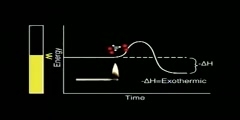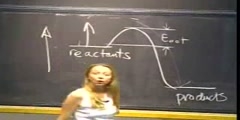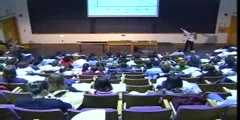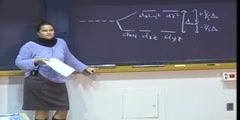Lec Last - Potential Energy Surfaces, Transition State Theory and Reaction Mechanism
"Lec Last - Potential Energy Surfaces, Transition State Theory and Reaction Mechanism" Freshman Organic Chemistry (CHEM 125) After discussing the statistical basis of the law of mass action, the lecture turns to developing a framework for understanding reaction rates. A potential energy surface that associates energy with polyatomic geometry can be realized physically for a linear, triatomic system, but it is more practical to use collective energies for starting material, transition state, and product, together with Eyring theory, to predict rates. Free-radical chain halogenation provides examples of predicting reaction equilibria and rates from bond dissociation energies. The lecture concludes with a summary of the semester's topics from the perspective of physical-organic chemistry. 00:00 - Chapter 1. The Boltzmann Factor and Entropy Against Traditional Views on Society 07:40 - Chapter 2. The Statistical Basis of the Law of Mass Action 13:13 - Chapter 3. Understanding Reaction Rates: The Potential Energy Surface and Collective Energies 29:40 - Chapter 4. Free Radical Halogenations: Predicting Reaction Equilibria and Rates 43:01 - Chapter 5. A Summary of the First Semester Complete course materials are available at the Open Yale Courses website: http://open.yale.edu/courses This course was recorded in Fall 2008.
Video is embedded from external source so embedding is not available.
Video is embedded from external source so download is not available.
Channels: Chemistry (General)
Tags: Transition State Theory Potential Energy surface bond dissociation energy
Uploaded by: yalefreshorganic ( Send Message ) on 05-09-2012.
Duration: 47m 44s
Here is the next lecture for this course
Lec 86 - Potential energy stored in a spring
10:00 | 4475 viewsLec 87 - Spring potential energy example ...
09:38 | 3778 viewsLec 112 - Electric Potential Energy
12:37 | 5047 viewsLec 113 - Electric Potential Energy (part ...
09:50 | 4224 viewsLec 86 - Intermolecular Potential Energy
02:06 | 2834 viewsActivation energy
01:16 | 18036 viewsChemical Science-Atomic Theory of Matter ...
41:59 | 31633 viewsChemical Science - Free Energy of Formati ...
47:47 | 20258 viewsLec 53 - Renewable Energy and the Economy
59:35 | 4328 viewsLec 1 - Law 270.7 Introduction to Renew ...
01:15:15 | 4457 viewsLec 7 - Quantum Mechanical Kinetic Energy
49:18 | 8051 viewsLec 13 - Overlap and Energy-Match
49:44 | 3165 viewsChemical Science - Transition Metals - Le ...
49:42 | 15151 viewsChemical Science - Kinetics: Catalysis - ...
48:23 | 17600 viewsLec 5 - Work-Energy Theorem and Law of Co ...
01:10:16 | 9884 viewsNo content is added to this lecture.
This video is a part of a lecture series from of Yale
Lecture list for this course
Lec 2 - Force Laws, Lewis Structures and Resonance
Lec 3 - Double Minima, Earnshaw's Theorem and Plum-Puddings
Lec 4 - Coping with Smallness and Scanning Probe Microscopy
Lec 6 - Seeing Bonds by Electron Difference Density
Lec 7 - Quantum Mechanical Kinetic Energy
Lec 8 - One-Dimensional Wave Functions
Lec 9 - Chladni Figures and One-Electron Atoms
Lec 10 - Reality and the Orbital Approximation
Lec 11 - Orbital Correction and Plum-Pudding Molecules
Lec 12 - Overlap and Atom-Pair Bonds
Lec 13 - Overlap and Energy-Match
Lec 14 - Checking Hybridization Theory with XH_3
Lec 15 - Chemical Reactivity: SOMO, HOMO, and LUMO
Lec 16 - Recognizing Functional Groups
Lec 17 - Reaction Analogies and Carbonyl Reactivity
Lec 18 - Amide, Carboxylic Acid and Alkyl Lithium
Lec 19 - Oxygen and the Chemical Revolution (Beginning to 1789)
Lec 20 - Rise of the Atomic Theory (1790-1805)
Lec 21 - Berzelius to Liebig and Wöhler (1805-1832)
Lec 22 - Radical and Type Theories (1832-1850)
Lec 23 - Valence Theory and Constitutional Structure (1858)
Lec 24 - Determining Chemical Structure by Isomer Counting (1869)
Lec 25 - Models in 3D Space (1869-1877); Optical Isomers
Lec 26 - Van't Hoff's Tetrahedral Carbon and Chirality
Lec 27 - Communicating Molecular Structure in Diagrams and Words
Lec 28 - Stereochemical Nomenclature; Racemization and Resolution
Lec 29 - Preparing Single Enantiomers and the Mechanism of Optical Rotation
Lec 30 - Esomeprazole as an Example of Drug Testing and Usage
Lec 31 - Preparing Single Enantiomers and Conformational Energy
Lec 32 - Stereotopicity and Baeyer Strain Theory
Lec 33 - Conformational Energy and Molecular Mechanics
Lec 34 - Sharpless Oxidation Catalysts and the Conformation of Cycloalkanes
Lec 35 - Understanding Molecular Structure and Energy through Standard Bonds
















